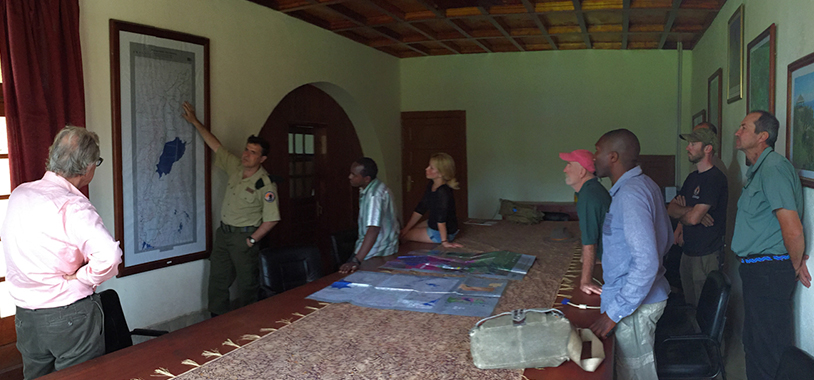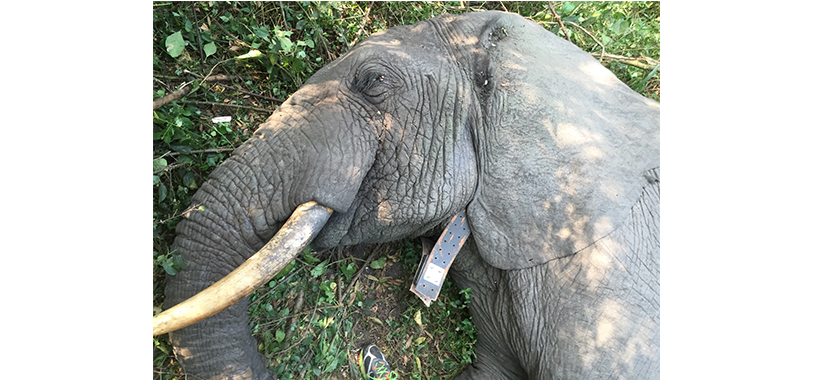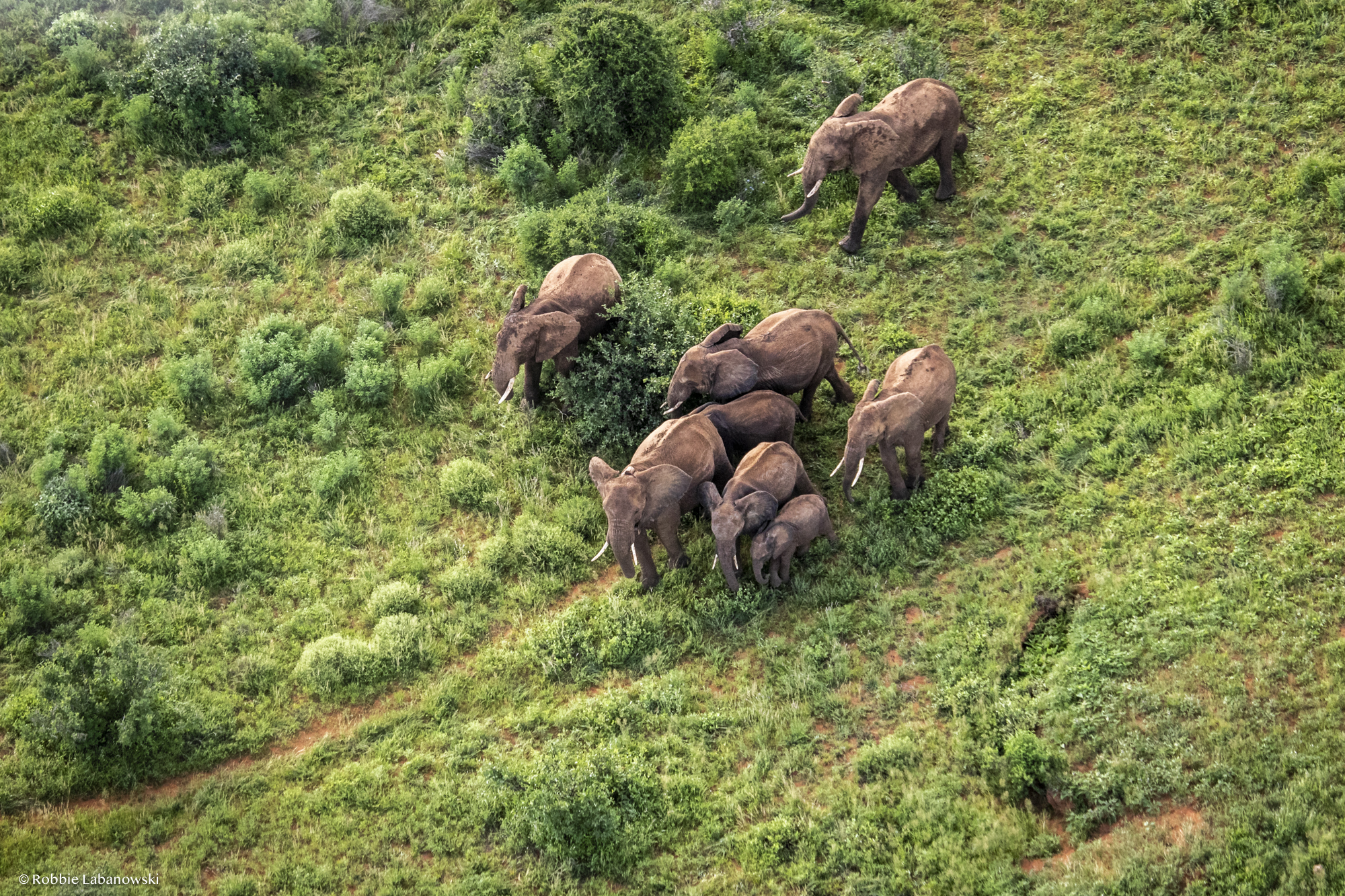In late July Save the Elephants flew to Virunga National Park in the Democratic Republic of Congo to deploy tracking collars to protect the last of its elephants from poachers. In the 1980s the national park – Africa’s oldest – was estimated to have over 8,000 elephants. Today estimates say only 400 remain. Catching even a handful of these to act as sentinels for the others would prove tough.
Virunga’s beauty and biological diversity are legendary. But so too are its challenges. Decades of war have ravaged the area, leaving 4 million people in and around the park and at least three rebel militia groups preying on its resources. Just two weeks before we arrived, in one of the areas where we planned to deploy collars, eleven rangers were killed when they were attacked by a combined force of uniformed FDLR rebels, and Mai Mai who were naked but for the charms they wear to protect them from bullets.
The park stretches in a long, thin ribbon from the Virunga volcanoes in the south where the mountain gorillas live and where the world’s largest lava lakes bubble, through savannahs bordered by a dramatic escarpment before hitting Lake Edward. The northern edge of the lake drains into the Semliki river – one of the sources of the Nile – and the park follows its path north past the snow capped peaks of the Mountains of the Moon.
Emmanuel de Merode, the National Park’s Director, had requested fifteen collars to follow the movements of three of the remaining elephant populations. Elsewhere in Africa – including in the area around our research base in Samburu, Northern Kenya, real-time monitoring of elephant movements has proved an invaluable tool for security managers. With their positions and tracks easily visualised on our Google Earth-based system they are able to plan the deployment of patrols to protect the herds effectively.

Emmanuel briefs the team on the operational requirements of the elephant tracking
And this is just the start. The tracking system we developed is at the core of a new “Domain Awareness System” that we are developing with Vulcan, Paul Allen’s foundation, in partnership with Google, the Wildlife Conservation Society, the Zoological Society of London, African Parks and Lewa Wildlife Conservancy. This will be a powerful, flexible tool for defending protected areas through integrating the various data feeds from animal tracking, ranger communications and asset movements.
We began on the easiest population, to the southeast of Lake Edward. With the generous support of African Parks we were able to use their helicopter and battle-hardened pilot, Frank Molteno. Together with top South-African vet Pete Morkel and STE research assistant Jerenimo Lepirei under Iain Douglas-Hamilton’s guidance they made a formidable team. On the first afternoon we deployed two, and the following morning another four.
The first of those collared that morning looked like a forest elephant, with small, round ears and straight sharp tusks pointed directly downwards. Fascinatingly he was together with two bulls that looked typical of the savannah type. Virunga is one of the few places where both types are found, and seeing them together that morning suggested to us that the two are more intermingled than is sometimes thought. The following day we darted a savannah type elephant deep in the forest.

Kasale with his collar shortly before being revived. Note his small ears and straight tusks, typical of a forest elephant
We had plenty of dramas. More than anywhere else we found the bulls of Virunga appear to be protective types. One charged us in the thick forest just as we approached his sleeping friend, “Mabenga”, to fit his collar and retreated only after two shots were fired in the air. Another charged the helicopter team as they were starting to fit a female, “Kagezi”, with her collar.
When “Ishango” succumbed to the tranquilizer in a swamp next to the lake the helicopter could not land, so the team had to unload the equipment onto the sleeping elephant’s back. Pete wanted to make sure there were no breathing complications so he lightened the anaesthetic. Jerenimo was most alarmed to be fitting a collar to an elephant whose eyes were open and ears were flapping as if completely awake. Luckily “Ishango” didn’t stir until given the full dose of antidote.
Given half a chance Pete the vet would go on foot, rather than use the helicopter, to keep the elephant as calm as possible. On one occasion a particularly nervous bull – named “Wasiwasi” (Kiswahili for ‘nervous’) had absorbed the drug from one dart and not gone down. Rather than use the helicopter to put in another dart and risk the uncertainty of the dart not going in properly, he had himself put down on the ground and walked in. I was circling high overhead watching in 5Y-STE, and couldn’t believe my eyes when I saw Pete follow the elephant for a few hundred metres, watch for a few seconds, then creep up behind the still-standing bull and inject the supplemental drug by hand.
In just over a week we managed to fit 15 tracking collars onto Virunga’s elephants. Several elephant families we saw clustered around ranger posts, suggesting that they had learned to distinguish the heavily armed rangers as harmless, as distinct from the poachers. In one rebel-afflicted area, elephants had adopted a ranger checkpoint where heavy trucks laden with charcoal and hardwoods rumbled through every few minutes, yet somehow the elephants sensed that they were safe there and walked close to the voluble rangers.
Many elephant groups we saw appeared abnormal . In the forest we came across a large bull being trailed closely by a 4 year-old orphan, with no females to be found anywhere close.
Overall Virunga is an extraordinary story of hope in the most challenging of circumstances. The well led ranger force is determined to do the right thing in the teeth of overwhelming pressure. You get the sense of enormous stakes, primeval forces of good and evil, where the fate of elephants will be determined by their protectors in the face of enormous odds.

A bull herd near Lulimbi. Although few in number, the elephants we encountered in Virunga were fine specimens, in good condition. From this group we now track two individuals, Emmanuel and Balenga

